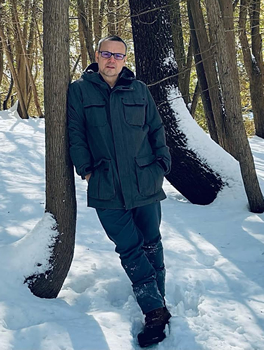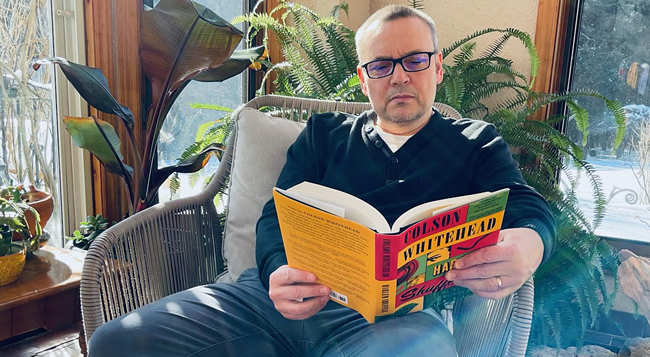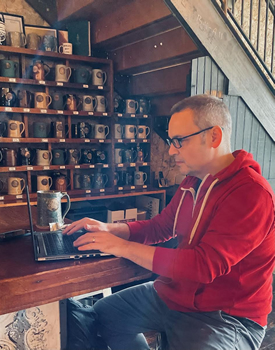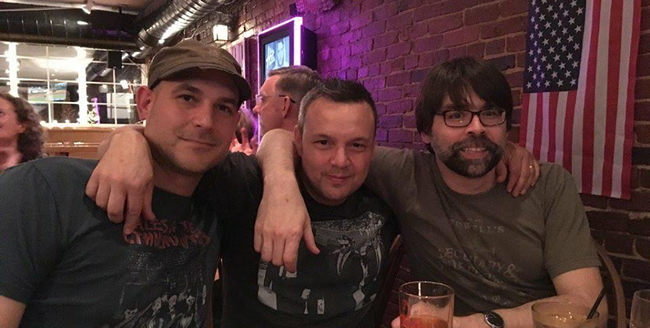

Up Close: Rio Youers
Creating Film-Worthy Action and Thrills
 By Dawn Ius
By Dawn Ius
Rio Youers wants you to be on the edge of your seat while reading NO SECOND CHANCES. He wants you to have a good time. He wants you to feel like you’re at the movies with every pulse-pounding page, even if you’re perched on your couch with the lights cranked to very bright.
In this case, Youers pretty much gets what he wants.
To say that NO SECOND CHANCES is simply an action thriller would be an understatement. It’s about as close as one gets to a movie-going experience reminiscent of Mission: Impossible—without vaulting into the realm of the implausible.
In it, we follow Kitty Rae to Hollywood as she chases her dream of becoming an actress. As is often the case with these kinds of coming of age journeys, it doesn’t go well for Kitty. She soon finds herself in the dangerous employ of Johan Fly—a very bad guy the Stephen King calls “the best villain since Ian Fleming’s James Bond novels”—and seeks rescue from an unlikely knight, former actor and accused wife-killer Luke Kingsley.
As it turns out, helping Kitty to uncover a web of lies and corruption also leads to a clue about Luke’s presumed-dead wife, Lisa, sending them on a journey across the Mojave Desert—with a very angry Johan hot on their tales.
If NO SECOND CHANCES doesn’t get your heart pumping, you may want to check your pulse. In this interview with The Big Thrill, Canadian author Rio Youers shares insight into how he achieved gritty thrills, while still keeping things real.
NO SECOND CHANCES is one of the most adrenaline-fueled action thrillers I’ve read in a while—what can you share about the inspiration for the story?
There were a few sparks of inspiration. First, the location; I’d always wanted to set a novel in California, possibly because most of my stories take place in the Northeast, and I felt it was time to stretch my wings. I knew it would be a challenge, but it was one I was excited to take on. Also, I live in Canada, where it can get very cold. The idea of palm trees and sunshine—if only in my mind—was incredibly appealing to me.
Second, I’d been thinking a lot about the precipice of fame—how a great and elevated position can lead to a tremendous fall. I wanted to explore that from both sides, to delve into those dreams and fears and find the truths within.
Third, the characters. My protagonists, Luke Kingsley and Kitty Rae, had been hanging out in my mind for a couple of years. I didn’t know much about them—only that Luke was an actor whose career had taken a nosedive, and that Kitty had dreams of making it big in Hollywood. What can I say? I wanted to hang out with them, to jump into their stories and see what fate had in store for them. Then Johan Fly, my antagonist, crashed the party, bringing all of his chaos and charisma with him. At that point, the threads of a story started to come together, combining the other elements I’d wanted to explore (the California setting, the precipice of fame). That’s an exhilarating time for any writer…when an idea goes from a spark to a flame, and then to a tiny burning sun—a source of creativity and energy. I just love when that happens.
The book has a very cinematic feel, and not only because some of it is set in Los Angeles. The Big Thrill is as much for aspiring writers as it is for thriller readers. What tips would you offer for achieving that made-for-film feel you’ve captured in NO SECOND CHANCES?
In the realm of a contemporary thriller novel, there’s a distinct disadvantage, in that your story—and your action—has to be grounded in reality. When you stretch the bounds of what is believable, you risk losing the reader. (All the crazy stuff that Tom Cruise does in the Mission: Impossible movies … try that in a novel, and you’re going to get a lot of notes from your editor.) That being said, don’t be afraid to go big, or to flirt with the improbable. Fiction is entertainment, so be entertaining. Me … I play the scene out in my head as if I’m watching a movie, then I take it as far as I can—I push all the way to the edge. Reading it back, if I feel I’ve gone too far—a little too John Woo—I’ll tone it down. And if I have to, I’ll tone it down again in later drafts.
Ultimately, achieving that cinematic action flavor is like playing the drums: It’s good to be loud and proud, but you have to have rhythm. Another thing to bear in mind: action is exhausting to write, but it can also be exhausting to read. Go big and go wild, but always stay in control.
The story, despite its potentially glamorous roots (chasing the Hollywood dream), can get pretty violent, though it never felt over the top. In what ways do you use violence to flesh out the story?
Violence adds a layer of grim reality that the reader can identify with, because, unfortunately, we live in a violent society. Making something relatable better invests the reader. It enhances the experience on a visceral level and stimulates powerful emotion. You don’t see that in slasher movies, because the violence is designed to entertain. The audience wants the over-the-top kills. It wants the blood. But in movies and TV shows where there’s a greater investment in character and story, and where the audience doesn’t necessarily want the blood (Ozark comes immediately to mind), the violence becomes an incredibly powerful tool, and one that has to be used carefully.
Despite the darkness, you’ve infused some lighthearted humor—what do you think is the role of humor in a thriller?
It’s actually a big deal for me. I mean, yeah … those lighthearted touches provide respite from some of the more breakneck, edge-of-the-seat moments. But that’s not all, and it’s not even the most important thing—at least not for me. Humor (used correctly) can add sweetness to a scene and humanness to a character, which will always elevate the reader’s experience. And really, that’s what it’s all about—taking the reader on one heck of a ride and making them feel every possible emotion along the way.
But again, like the cinematic action scenes (and the violence), you can’t overdo it. It’s about timing and rhythm. You have to stay in control.
Arguably, Stephen King has created some of the best “bad guys”—and he had some excellent things to say about the villain in NO SECOND CHANCES, Johan Fly. What did his praise mean to you?

Youers enjoys hiking the trails around his Southern Ontario home. “It gives me the time to think through story roadblocks and potential plot holes,” he says.
Talk to anybody who knows me, and they’ll tell you that I’m a huge Stephen King fan and have been since my early teenage years. No other writer has come close to entertaining and inspiring me in the way Stephen King has. I’m not alone there, by the way. So many—nearly all, in fact—of my writer friends feel the same way. Stephen King is to fiction what the Beatles are to popular music, and to have him endorse NO SECOND CHANCES was surreal and wonderful.
Really, I’m just a guy from a working-class background. I see King’s blurb on the front of my book, and it feels like I’m living somebody else’s dream.
Speaking of great characters, I love Kitty Rae, who we follow to Hollywood while she chases her dreams of being an actress. This is a trope that has been done before, but in NO SECOND CHANCES you provide a fresh perspective on the dark side of Hollywood. What can you share about the inspiration for Kitty’s character?
Kitty. Oh my goodness. She came to life for me. That happens sometimes—a character just jumps up and takes off. You have to catch up, of course, but the chase is exhilarating.
I mentioned in an earlier answer that Kitty had dropped into my mind long before any plot or story elements had formed. I knew she would be strong and ambitious, but I didn’t know to what extent she would carry the narrative, or how her strength would inspire Luke (my male protagonist) to find his. In fact, I thought NO SECOND CHANCES would principally be Luke’s story, with Kitty in more of a supporting role. It turned out to be the other way around; Kitty has way too much sass and verve to ride shotgun, and I love that about her.
In regard to inspiration … I look to the strong women in my life, always, and to anybody with a dream and the tenacity to shoot for it.

Youers always makes time to read. “It’s the secret to successful writing,” he says. “It fuels the machine and keeps it tuned.”
NO SECOND CHANCES delves into the very real and timely issue of “cancel culture”—what do you hope readers take away from this story aside from a pulse-pounding read?
We think we know celebrities, because they put themselves on display—they’re in the public eye. In truth, they exist behind a highly polished veneer, and we don’t really know them at all. We see only what they want to show us, and understandably so. With NO SECOND CHANCES, I was interested in peeling away this veneer and exposing the real, fallible individual beneath. A celebrity—like anybody—may be perceived as wholesome and good, while actually disguising something quite sinister. The opposite is also true, of course, and I wanted to explore both sides.
It’s not a political book, and I’m not standing on a soapbox. All I want is for my readers to have a good time—to meet these characters and see what makes them tick, and to see how they react when I toss a hand grenade into their shimmery celebrity lives.
Your writing career started out in horror—but NO SECOND CHANCES is firmly planted in the thriller genre. What about the genres attracts you, and why the shift from horror?
Horror is fun. I’ve always favored character over plot, and with horror I’m drawn to seeing how much I can put my characters through and have them emerge on the other side. There’s also the challenge of taking the esoteric and supernatural and making it believable for the reader. That’s where the fear lies, and it’s powerful, but it can only happen if they have a strong and real connection to the character.
I use a similar dynamic in my thriller novels, but as I’ve already mentioned, everything has to be grounded in reality. There are no supernatural events or solutions. It’s a stricter set of rules, which exercises different writing muscles.
I made the shift because I always wanted to write a thriller novel—something big and fun, but with tons of heart and character. What I really wanted was to take the balls-to-the-wall action formula we see in movies like John Wick and Kill Bill and see if it could work in book form. I saw a way it could be done and wrote a novel call Lola on Fire. And yeah, it was fun. It was a riot with soul. It was everything I wanted it to be. And now there’s NO SECOND CHANCES, which—as Stephen King says—smashes the pedal to the metal and keeps it there. I had a blast with it, and I think readers will, too.
In addition to writing thriller novels, you’re working on comic books for DC. Can you share a little about your involvement in Refrigerator Full of Heads (or other comics)?
I’ve written two comic series: Refrigerator Full of Heads for DC Comics (a sequel to Basketful of Heads by Joe Hill), and Sleeping Beauties for IDW (based on the bestselling novel by Stephen King and Owen King). Both comics required a different approach, with one being an adaptation, but the process was equally rewarding, and I got to work with some of the best creators in the industry.
Chris Ryall (formerly at IDW) approached me about Sleeping Beauties. Chris is a long-time friend and fan of my work—as is Owen King—and we’d been looking for a project to do together for some time. Sleeping Beauties was a perfect fit. I mean, I say that, but I’d never really worked in comics before, and the idea of adapting a 700-page King novel was somewhat daunting. But, as you can probably tell by now, I’ve never been one to shy away from a challenge.
It was daunting, but I had a great time, and I learned so much during the writing process. Owen was on hand to run through the scripts and make sure they aligned with his overall vision, and I know that he and Stephen King are very happy with how the series turned out. And a big shoutout, of course, to Alison Sampson and Triona Farrell, who provided such mesmerizing artwork.
Not long after I finished Sleeping Beauties, Joe Hill approached me about a possible sequel to Basketful of Heads. Again, Joe’s a long-time friend. We’re the same age, we were discovered by the same small-press publisher, we had the same literary agent for a while, and we have the same publisher now. There are certain parallels, and I always felt it was just a matter of time before we worked on something together. We had several phone calls in which we bounced ideas around, then I started on the pitch. It took a few attempts, but I landed on something we were both happy with, then we took it to DC. Everything moved pretty quickly after that. The series got the green light, I went to work on the script, and the first issue of Refrigerator Full of Heads came out in October of 2021.
It’s a big, gruesome splatterfest of a comic, with art by Tom Fowler and colors by Bill Crabtree, and I couldn’t be happier with it!
What, if anything, can you share about your next work in progress?
Let me see … yeah, I’m digging into something new—another blazing action novel with a truckload of heart and soul. I don’t want to say too much, because it’s early in the process, but I’m supercharged for it, and every day I look forward to jumping in and seeing where the story takes me. (Pssst—that’s a very good sign!)
- On the Cover: Alisa Lynn Valdés - March 31, 2023
- On the Cover: Melissa Cassera - March 31, 2023
- Behind the Scenes: From Book to Netflix - March 31, 2023



